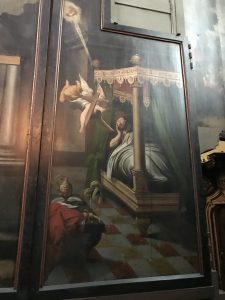“For in the night a glowing man appearing to [Constantine] showed him the sign of the Holy Cross, and promised a victory to him through this sign. After he was awakened, he recalled the dream to friends, and the cross having been made with a banner, he set it before the troops.”*
In this sermon on the Finding of the Holy Cross, Honorius Augustodunensis, recounted the story of Constantine the Great’s dream of the sign of the cross before the famous battle of the Milvian Bridge in AD 312. This sermon from the early twelfth century demonstrates how this story became a standard part of sermons on the Holy Cross. After this description of Constantine’s victory, Honorius describes how Constantine’s mother, Helena, went to Jerusalem in search of the piece of wood on which Christ was crucified.
According to the tradition that Honorius repeats here, Helena believed a group of Jews had hidden the relic of the Holy Cross. Therefore, she brought them together and offered them a reward or punishment for the location of the relic. After Helena ordered a certain Jew to be thrown into a pit, that man, Judah, showed her the place where the crosses of Christ and two thieves were hidden. Honorius described this event in the following way:
“Indeed the queen met with the people, and went to the place, [and] poured forth prayers on bended knees. The place shook, the smoke of incense rose up from the earth. Then, they opened the earth with shovels and found three crosses. A dead man was carried to the cross of Christ and placed upon him it raised him from the dead. He bore witness to the power of the Holy Cross by his own resurrection and voice. Also then they found the glittering nails by which the Jews stabbed the hands and feet of the Lord.”**
As a result of this event, Honorius explains, numerous Jews believed in Christ and were baptized. Judah became the bishop of Jerusalem and took the name Quiriacus. According to the legend, he suffered martyrdom under Julian the Apostate later. Honorius then describes how Helena built a magnificent church in Jerusalem for a piece of the Holy Cross and brought another piece back to Constantinople.
*Honorius Augustodunensis, De inventione sanctae crucis, PL 172:947B [my translation]
**Honorius, De inventione sanctae crucis, PL 172:947D-48A

